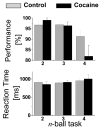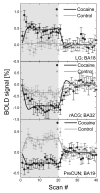Thalamo-cortical dysfunction in cocaine abusers: implications in attention and perception
- PMID: 17582746
- PMCID: PMC2265105
- DOI: 10.1016/j.pscychresns.2007.03.002
Thalamo-cortical dysfunction in cocaine abusers: implications in attention and perception
Abstract
Cocaine affects sensory perception and attention, but little is known about the neural substrates underlying these effects in the human brain. We used functional magnetic resonance imaging (fMRI) and a sustained visuospatial attention task to assess if the visual attention network is dysfunctional in cocaine abusers (n=14) compared to age-, gender-, and education-matched controls (n=14). Compared with controls, cocaine abusers showed (1) hypo-activation of the thalamus, which may reflect noradrenergic and/or dopaminergic deficits; (2) hyper-activation in occipital and prefrontal cortices, which may reflect increased visual cortical processing to compensate for inefficient visual thalamic processing; and (3) larger deactivation of parietal and frontal regions possibly to support the larger hemodynamic supply to the hyper-activated brain regions. These findings provide evidence of abnormalities in thalamo-cortical responses in cocaine abusers that are likely to contribute to the impairments in sensory processing and in attention. The development of therapies that diminish these thalamo-cortical deficits could improve the treatment of cocaine addiction.
Figures








References
-
- Adler C, Sax K, Holland S, Schmithorst V, Rosenberg L, Strakowski S. Changes in neuronal activation with increasing attention demand in healthy volunteers: an fMRI study. Synapse. 2001;42:266–272. - PubMed
-
- Aharonovich E, Hasin D, Brooks A, Liu X, Bisaga A, Nunes E. Cognitive deficits predict low treatment retention in cocaine dependent patients. Drug and Alcohol Dependence. 2006;81:313–322. - PubMed
-
- Arrington C, Carr T, Mayer A, Rao S. Neural mechanisms of visual attention: object-based selection of a region in space. Jounal of Cognitive Neuroscience. 2000;12(Suppl 2):106–117. - PubMed
-
- Ashburner J, Neelin P, Collins DL, Evans AC, Friston KJ. Incorporating prior knowledge into image registration. Neuroimage. 1997;6:344–352. - PubMed
Publication types
MeSH terms
Grants and funding
LinkOut - more resources
Full Text Sources
Medical

